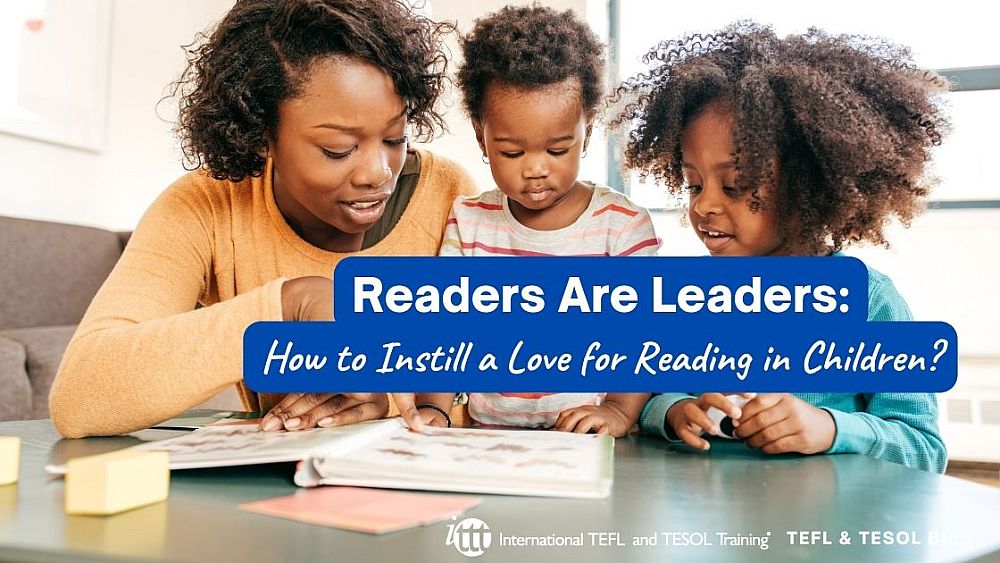Readers Are Leaders: How to Instill a Love for Reading in Children?

Children usually prioritize their joy and prefer rewarding activities. They are more interested in reading when it is rewarding and beneficial to them. Interestingly, children learning a second language find it easier to learn reading compared to those who are learning to read for the first time. This is because young second language (L2) learners have already experienced that reading can be interesting and entertaining. By making reading in a second language interesting, students are likely to be motivated.
Table of Contents
Text Difficulty and Vocabulary Support
Setting Achievable Reading Goals
Tailoring Reading Material to Children's Interests
Reading and Writing as Positive Activities
Empowering Children's Choice in Reading
Engaging Activities to Enhance Reading Experience
Are you ready to teach English as a foreign language?
Check out what our course grads say in our many video testimonials!
Disclaimer: The views and opinions expressed in this blog post are solely those of the author, an alumni of ITTT (International TEFL and TESOL Training). They do not necessarily reflect the views or opinions of ITTT. The content provided in this post is for informational purposes only and should not be considered as official endorsement or representation by ITTT.
Text Difficulty and Vocabulary Support
One important aspect of motivation is ensuring that the text is not too difficult. Too many complex words can hinder understanding and enjoyment. Teachers should ensure that the chosen texts align with the student's language level. If the text is beyond their level, vocabulary lists can be provided in advance to help with the comprehension of complex words. Not all difficult words need to be translated or explained, but it's important to provide enough support for students to follow and understand the main point or plot.
Setting Achievable Reading Goals
Setting achievable reading goals is important not only in terms of text difficulty but also in terms of length. Many children enjoy the sense of accomplishment that comes with finishing a book, and they eagerly anticipate reaching the end of a plot. Teachers should consider the length of the texts or books assigned to maintain students' motivation and engagement.
Tailoring Reading Material to Children's Interests
It's essential to recognize that what makes reading interesting can vary depending on the age of the students. Teenagers are more likely to be interested in topics relevant to their own interests, current society, or even fun historical facts. On the other hand, children usually gravitate towards entertaining genres such as fantasy or adventure. A helpful tip is to offer books based on their favorite movies, as this can pique their interest and provide a familiar context for reading. While some books or texts may not personally interest an adult teacher, it is important to familiarize oneself with the material that our students are reading. By doing so, we can establish a shared context and effectively cultivate their interest in the material.
Reading and Writing as Positive Activities
Neither reading nor writing should ever be used as disciplinary tools. Associating reading with punishment creates negative connotations about the activity, which can hinder a child's enthusiasm for reading. Instead, we should foster a positive environment where reading and writing are seen as enjoyable and valuable activities.
Empowering Children's Choice in Reading
Whenever possible, it is beneficial to allow children to choose the books they read. Making a variety of books available in the classroom and providing book lists can help ignite their interest in reading and reduce unnecessary pressure. Unlike assigned texts, reducing pressure is particularly important when it comes to reading books. Books require focus and concentration, which some children may struggle with. By offering a choice among interesting books, we can alleviate this pressure and give young students the freedom to explore their own preferences in genres and themes.
Engaging Activities to Enhance Reading Experience
Another important teaching skill to maintain students' interest in reading is the ability to extract interesting elements from a text and draw the students' attention to them. For very young children, choosing books with illustrations and reading together can have a positive effect. Young children often have vivid imaginations, and this can be encouraged by allowing them to illustrate what they have read through drawing or playacting. Depending on the age group, various activities can be incorporated, such as writing essays about their favorite characters, crafting alternative endings to stories, role-playing characters, or engaging in debates.
By employing these strategies, teachers can effectively instill a love for reading in children, nurturing their curiosity and helping them become lifelong readers and leaders.
Are you ready to teach English as a foreign language?
Apply now & get certified to teach english abroad!
Speak with an ITTT advisor today to put together your personal plan for teaching English abroad!
Send us an email or call us toll-free at 1-800-490-0531 to speak with an ITTT advisor today.
Related Articles:
- Top 10 Cities in Europe with the Highest Demand for English Language Teachers
- 5 Reasons To Take A TEFL Course Right Now - Even If You Are Not Leaving Yet | ITTT | TEFL Blog
- All the Documents You Will Need to Teach English Abroad
- The Impact of Positive Motivation on an ESL Classroom
- You're Never Too Old to Change Your Life and Do a TEFL Course | ITTT | TEFL Blog
- Getting Student Placement Right - The Best Desk Arrangements for EFL Students



